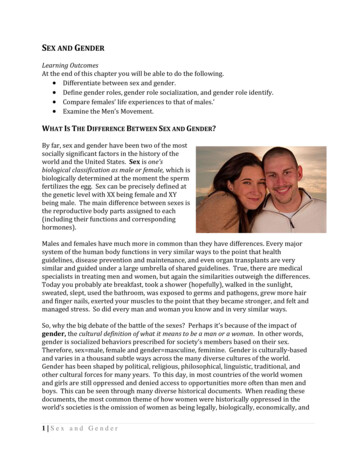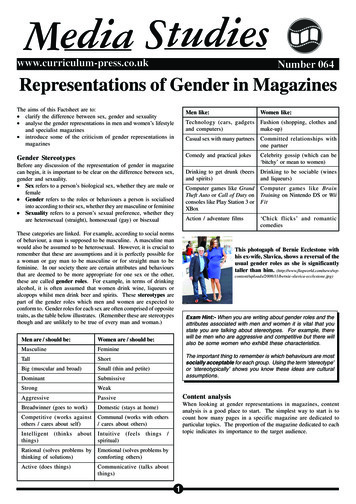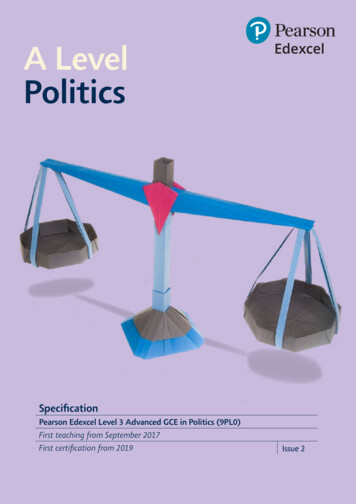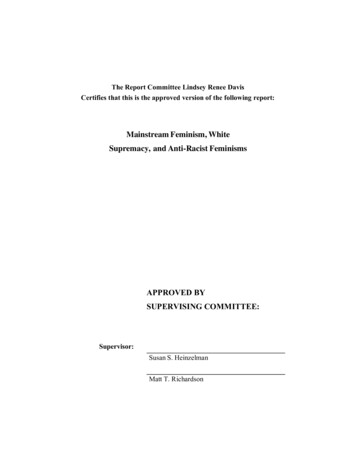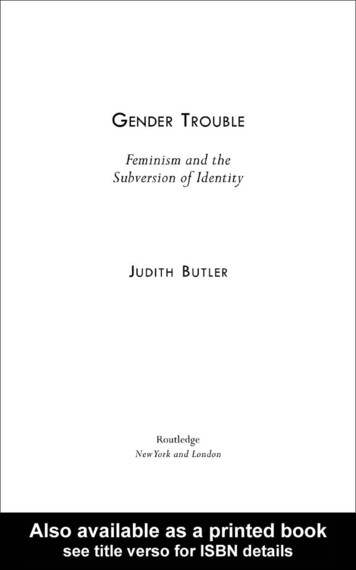
Transcription
GENDER TROUBLE
GENDER TROUBLEFeminism and theSubversion of IdentityJ UDITH B UTLERRoutledgeNew York and London
Published in 1999 byRoutledge29 West 35th StreetNew York, NY 10001Published in Great Britain byRoutledge11 New Fetter LaneLondon EC4P 4EEThis edition published in the Taylor & Francis e-Library, 2002.Copyright 1990, 1999 by RoutledgeGender Trouble was originally published in the Routledge book seriesThinking Gender, edited by Linda J. Nicholson.All rights reserved. No part of this book may be reprinted or reproduced orutilized in any form or by any electronic, mechanical, or other means, nowknown or hereafter invented, including photocopying and recording or inany information storage or retrieval system, without permission in writingfrom the publishers.Library of Congress Cataloging-in-Publication DataButler, Judith P.Gender trouble : feminism and the subversion of identity / JudithButler.p. cm.Includes bibliographical references and index.Originally published: New York : Routledge, 1990.ISBN 0-415-92499-5 (pbk.)1. Feminist theory. 2. Sex role. 3. Sex differences (Psychology)4. Identity (Psychology) 5. Femininity. I.Title.HQ1154.B898 1999305.3—dc2199-29349CIPISBN 0-203-90275-0 Master e-book ISBNISBN 0-203-90279-3 (Glassbook Format)
ContentsOnePreface ( )viiPreface ( )xxviiSubjects of Sex/Gender/Desire3i“Women” as the Subject of Feminism3iiThe Compulsory Order of Sex/Gender/Desire9iiiivvviTwoiGender:The Circular Ruinsof Contemporary Debate11Theorizing the Binary, the Unitary,and Beyond18Identity, Sex, and the Metaphysicsof Substance22Language, Power, and the Strategiesof Displacement33Prohibition, Psychoanalysis,and the Production of theHeterosexual Matrix45Structuralism’s Critical Exchange49v
ContentsLacan, Riviere, and the Strategiesof Masquerade55iiiFreud and the Melancholia of Gender73ivGender Complexity and the Limitsof Identification84Reformulating Prohibition as Power91iivThreeSubversive Bodily Acts101iThe Body Politics of Julia Kristeva101iiFoucault, Herculine, and the Politicsof Sexual Discontinuity119Monique Wittig: Bodily Disintegrationand Fictive Sex141Bodily Inscriptions, PerformativeSubversions163From Parody to Politics181Notes191Index217iiiivConclusionvi
Preface ( )Ten years ago I completed the manuscript of Gender Trouble and sent itto Routledge for publication. I did not know that the text would haveas wide an audience as it has had, nor did I know that it would constitute a provocative “intervention” in feminist theory or be cited as oneof the founding texts of queer theory.The life of the text has exceededmy intentions, and that is surely in part the result of the changing context of its reception. As I wrote it, I understood myself to be in anembattled and oppositional relation to certain forms of feminism, evenas I understood the text to be part of feminism itself. I was writing inthe tradition of immanent critique that seeks to provoke critical examination of the basic vocabulary of the movement of thought to which itbelongs. There was and remains warrant for such a mode of criticismand to distinguish between self-criticism that promises a more democratic and inclusive life for the movement and criticism that seeks toundermine it altogether. Of course, it is always possible to misread theformer as the latter, but I would hope that that will not be done in thecase of Gender Trouble.In 1989 I was most concerned to criticize a pervasive heterosexualassumption in feminist literary theory. I sought to counter those viewsthat made presumptions about the limits and propriety of gender andrestricted the meaning of gender to received notions of masculinityand femininity. It was and remains my view that any feminist theoryvii
Gender Troublethat restricts the meaning of gender in the presuppositions of its ownpractice sets up exclusionary gender norms within feminism, oftenwith homophobic consequences. It seemed to me, and continues toseem, that feminism ought to be careful not to idealize certain expressions of gender that, in turn, produce new forms of hierarchy andexclusion. In particular, I opposed those regimes of truth that stipulated that certain kinds of gendered expressions were found to be false orderivative, and others, true and original. The point was not to prescribe a new gendered way of life that might then serve as a model forreaders of the text. Rather, the aim of the text was to open up the fieldof possibility for gender without dictating which kinds of possibilitiesought to be realized. One might wonder what use “opening up possibilities” finally is, but no one who has understood what it is to live inthe social world as what is “impossible,” illegible, unrealizable, unreal,and illegitimate is likely to pose that question.Gender Trouble sought to uncover the ways in which the very thinking of what is possible in gendered life is foreclosed by certain habitualand violent presumptions. The text also sought to undermine any andall efforts to wield a discourse of truth to delegitimate minority gendered and sexual practices. This doesn’t mean that all minority practices are to be condoned or celebrated, but it does mean that we oughtto be able to think them before we come to any kinds of conclusionsabout them.What worried me most were the ways that the panic in theface of such practices rendered them unthinkable. Is the breakdown ofgender binaries, for instance, so monstrous, so frightening, that it mustbe held to be definitionally impossible and heuristically precludedfrom any effort to think gender?Some of these kinds of presumptions were found in what wascalled “French Feminism” at the time, and they enjoyed great popularity among literary scholars and some social theorists.Even as I opposed what I took to be the heterosexism at the core ofsexual difference fundamentalism, I also drew from French poststructuralism to make my points. My work in Gender Trouble turned out to beviii
Preface 1999one of cultural translation. Poststructuralist theory was brought to bearon U.S. theories of gender and the political predicaments of feminism. Ifin some of its guises, poststructuralism appears as a formalism, alooffrom questions of social context and political aim, that has not been thecase with its more recent American appropriations. Indeed, my pointwas not to “apply” poststructuralism to feminism, but to subject thosetheories to a specifically feminist reformulation.Whereas some defenders of poststructuralist formalism express dismay at the avowedly “thematic” orientation it receives in works such as Gender Trouble, thecritiques of poststructuralism within the cultural Left have expressedstrong skepticism toward the claim that anything politically progressivecan come of its premises. In both accounts, however, poststructuralismis considered something unified, pure, and monolithic. In recent years,however, that theory, or set of theories, has migrated into gender andsexuality studies, postcolonial and race studies. It has lost the formalismof its earlier instance and acquired a new and transplanted life in thedomain of cultural theory. There are continuing debates about whethermy own work or the work of Homi K. Bhabha, Gayatri ChakravortySpivak, or Slavoj Žižek belongs to cultural studies or critical theory, butperhaps such questions simply show that the strong distinction betweenthe two enterprises has broken down.There will be theorists who claimthat all of the above belong to cultural studies, and there will be culturalstudies practitioners who define themselves against all manner of theory(although not, significantly, Stuart Hall, one of the founders of culturalstudies in Britain). But both sides of the debate sometimes miss thepoint that the face of theory has changed precisely through its culturalappropriations. There is a new venue for theory, necessarily impure,where it emerges in and as the very event of cultural translation.This isnot the displacement of theory by historicism, nor a simple historicization of theory that exposes the contingent limits of its more generalizable claims. It is, rather, the emergence of theory at the site wherecultural horizons meet, where the demand for translation is acute andits promise of success, uncertain.ix
Gender TroubleGender Trouble is rooted in “French Theory,” which is itself a curiousAmerican construction. Only in the United States are so many disparatetheories joined together as if they formed some kind of unity. Althoughthe book has been translated into several languages and has had an especially strong impact on discussions of gender and politics in Germany, itwill emerge in France, if it finally does, much later than in other countries. I mention this to underscore that the apparent Francocentrism ofthe text is at a significant distance from France and from the life of theory in France. Gender Trouble tends to read together, in a syncretic vein,various French intellectuals (Lévi-Strauss, Foucault, Lacan, Kristeva,Wittig) who had few alliances with one another and whose readers inFrance rarely, if ever, read one another. Indeed, the intellectual promiscuity of the text marks it precisely as American and makes it foreign to aFrench context. So does its emphasis on the Anglo-American sociological and anthropological tradition of “gender” studies, which is distinctfrom the discourse of “sexual difference” derived from structuralistinquiry. If the text runs the risk of Eurocentrism in the U.S., it hasthreatened an “Americanization” of theory in France for those fewFrench publishers who have considered it.1Of course, “French Theory” is not the only language of this text. Itemerges from a long engagement with feminist theory, with the debateson the socially constructed character of gender, with psychoanalysis andfeminism, with Gayle Rubin’s extraordinary work on gender, sexuality,and kinship, Esther Newton’s groundbreaking work on drag, MoniqueWittig’s brilliant theoretical and fictional writings, and with gay andlesbian perspectives in the humanities. Whereas many feminists in the1980s assumed that lesbianism meets feminism in lesbian-feminism,Gender Trouble sought to refuse the notion that lesbian practice instantiates feminist theory, and set up a more troubled relation between thetwo terms. Lesbianism in this text does not represent a return to whatis most important about being a woman; it does not consecrate femininity or signal a gynocentric world. Lesbianism is not the erotic con-x
Preface 1999summation of a set of political beliefs (sexuality and belief are related ina much more complex fashion, and very often at odds with one another). Instead, the text asks, how do non-normative sexual practices callinto question the stability of gender as a category of analysis? How docertain sexual practices compel the question: what is a woman, what isa man? If gender is no longer to be understood as consolidated throughnormative sexuality, then is there a crisis of gender that is specific toqueer contexts?The idea that sexual practice has the power to destabilize genderemerged from my reading of Gayle Rubin’s “The Traffic in Women” andsought to establish that normative sexuality fortifies normative gender.Briefly, one is a woman, according to this framework, to the extentthat one functions as one within the dominant heterosexual frame andto call the frame into question is perhaps to lose something of one’ssense of place in gender. I take it that this is the first formulation of“gender trouble” in this text. I sought to understand some of the terrorand anxiety that some people suffer in “becoming gay,” the fear of losing one’s place in gender or of not knowing who one will be if onesleeps with someone of the ostensibly “same” gender.This constitutes acertain crisis in ontology experienced at the level of both sexuality andlanguage. This issue has become more acute as we consider variousnew forms of gendering that have emerged in light of transgenderismand transsexuality, lesbian and gay parenting, new butch and femmeidentities. When and why, for instance, do some butch lesbians whobecome parents become “dads” and others become “moms”?What about the notion, suggested by Kate Bornstein, that a transsexual cannot be described by the noun of “woman” or “man,” but mustbe approached through active verbs that attest to the constant transformation which “is” the new identity or, indeed, the “in-betweenness”that puts the being of gendered identity into question? Although somelesbians argue that butches have nothing to do with “being a man,” others insist that their butchness is or was only a route to a desired statusxi
Gender Troubleas a man. These paradoxes have surely proliferated in recent years,offering evidence of a kind of gender trouble that the text itself did notanticipate.2But what is the link between gender and sexuality that I soughtto underscore? Certainly, I do not mean to claim that forms of sexualpractice produce certain genders, but only that under conditions ofnormative heterosexuality, policing gender is sometimes used as a wayof securing heterosexuality. Catharine MacKinnon offers a formulationof this problem that resonates with my own at the same time that thereare, I believe, crucial and important differences between us. She writes:Stopped as an attribute of a person, sex inequality takes the form ofgender; moving as a relation between people, it takes the form ofsexuality. Gender emerges as the congealed form of the sexualizationof inequality between men and women.3In this view, sexual hierarchy produces and consolidates gender. It isnot heterosexual normativity that produces and consolidates gender,but the gender hierarchy that is said to underwrite heterosexual relations. If gender hierarchy produces and consolidates gender, and if gender hierarchy presupposes an operative notion of gender, then gender iswhat causes gender, and the formulation culminates in tautology. It maybe that MacKinnon wants merely to outline the self-reproducing mechanism of gender hierarchy, but this is not what she has said.Is “gender hierarchy” sufficient to explain the conditions forthe production of gender? To what extent does gender hierarchyserve a more or less compulsory heterosexuality, and how often aregender norms policed precisely in the service of shoring up heterosexual hegemony?Katherine Franke, a contemporary legal theorist, makes innovativeuse of both feminist and queer perspectives to note that by assumingthe primacy of gender hierarchy to the production of gender,MacKinnon also accepts a presumptively heterosexual model forthinking about sexuality. Franke offers an alternative model of genderxii
Preface 1999discrimination to MacKinnon’s, effectively arguing that sexual harassment is the paradigmatic allegory for the production of gender. Not alldiscrimination can be understood as harassment.The act of harassmentmay be one in which a person is “made” into a certain gender. But thereare others ways of enforcing gender as well. Thus, for Franke, it isimportant to make a provisional distinction between gender and sexual discrimination. Gay people, for instance, may be discriminatedagainst in positions of employment because they fail to “appear” inaccordance with accepted gendered norms. And the sexual harassmentof gay people may well take place not in the service of shoring up gender hierarchy, but in promoting gender normativity.Whereas MacKinnon offers a powerful critique of sexual harassment, she institutes a regulation of another kind: to have a gendermeans to have entered already into a heterosexual relationship of subordination. At an analytic level, she makes an equation that resonates withsome dominant forms of homophobic argument. One such view prescribes and condones the sexual ordering of gender, maintaining thatmen who are men will be straight, women who are women will bestraight.There is another set of views, Franke’s included, which offers acritique precisely of this form of gender regulation.There is thus a difference between sexist and feminist views on the relation between gender and sexuality: the sexist claims that a woman only exhibits herwomanness in the act of heterosexual coitus in which her subordinationbecomes her pleasure (an essence emanates and is confirmed in the sexualized subordination of women); a feminist view argues that gendershould be overthrown, eliminated, or rendered fatally ambiguous precisely because it is always a sign of subordination for women.The latteraccepts the power of the former’s orthodox description, accepts thatthe former’s description already operates as powerful ideology, butseeks to oppose it.I belabor this point because some queer theorists have drawnan analytic distinction between gender and sexuality, refusing a causalor structural link between them. This makes good sense from onexiii
Gender Troubleperspective: if what is meant by this distinction is that heterosexualnormativity ought not to order gender, and that such ordering ought tobe opposed, I am firmly in favor of this view.4 If, however, what ismeant by this is that (descriptively speaking), there is no sexual regulation of gender, then I think an important, but not exclusive, dimensionof how homophobia works is going unrecognized by those who areclearly most eager to combat it. It is important for me to concede,however, that the performance of gender subversion can indicate nothing about sexuality or sexual practice. Gender can be renderedambiguous without disturbing or reorienting normative sexuality atall. Sometimes gender ambiguity can operate precisely to contain ordeflect non-normative sexual practice and thereby work to keep normative sexuality intact.5 Thus, no correlation can be drawn, forinstance, between drag or transgender and sexual practice, and the distribution of hetero-, bi-, and homo-inclinations cannot be predictablymapped onto the travels of gender bending or changing.Much of my work in recent years has been devoted to clarifyingand revising the theory of performativity that is outlined in GenderTrouble.6 It is difficult to say precisely what performativity is not onlybecause my own views on what “performativity” might mean havechanged over time, most often in response to excellent criticisms,7 butbecause so many others have taken it up and given it their own formulations. I originally took my clue on how to read the performativity ofgender from Jacques Derrida’s reading of Kafka’s “Before the Law.”There the one who waits for the law, sits before the door of the law,attributes a certain force to the law for which one waits.The anticipation of an authoritative disclosure of meaning is the means by whichthat authority is attributed and installed: the anticipation conjures itsobject. I wondered whether we do not labor under a similar expectation concerning gender, that it operates as an interior essence thatmight be disclosed, an expectation that ends up producing the veryphenomenon that it anticipates. In the first instance, then, the performativity of gender revolves around this metalepsis, the way in whichxiv
Preface 1999the anticipation of a gendered essence produces that which it posits asoutside itself. Secondly, performativity is not a singular act, but a repetition and a ritual, which achieves its effects through its naturalizationin the context of a body, understood, in part, as a culturally sustainedtemporal duration.8Several important questions have been posed to this doctrine, andone seems especially noteworthy to mention here.The view that genderis performative sought to show that what we take to be an internalessence of gender is manufactured through a sustained set of acts, posited through the gendered stylization of the body. In this way, it showedthat what we take to be an “internal” feature of ourselves is one that weanticipate and produce through certain bodily acts, at an extreme, anhallucinatory effect of naturalized gestures. Does this mean that everything that is understood as “internal” about the psyche is therefore evacuated, and that internality is a false metaphor? Although Gender Troubleclearly drew upon the metaphor of an internal psyche in its early discussion of gender melancholy, that emphasis was not brought forward intothe thinking of performativity itself.9 Both The Psychic Life of Power andseveral of my recent articles on psychoanalytic topics have sought tocome to terms with this problem, what many have seen as a problematicbreak between the early and later chapters of this book. Although Iwould deny that all of the internal world of the psyche is but an effect ofa stylized set of acts, I continue to think that it is a significant theoreticalmistake to take the “internality” of the psychic world for granted.Certain features of the world, including people we know and lose, dobecome “internal” features of the self, but they are transformed throughthat interiorization, and that inner world, as the Kleinians call it, is constituted precisely as a consequence of the interiorizations that a psycheperforms. This suggests that there may well be a psychic theory of performativity at work that calls for greater exploration.Although this text does not answer the question of whether themateriality of the body is fully constructed, that has been the focus ofmuch of my subsequent work, which I hope will prove clarifying for thexv
Gender Troublereader.10 The question of whether or not the theory of performativitycan be transposed onto matters of race has been explored by severalscholars.11 I would note here not only that racial presumptions invariably underwrite the discourse on gender in ways that need to be madeexplicit, but that race and gender ought not to be treated as simpleanalogies. I would therefore suggest that the question to ask is notwhether the theory of performativity is transposable onto race, butwhat happens to the theory when it tries to come to grips with race.Many of these debates have centered on the status of “construction,”whether race is constructed in the same way as gender. My view is thatno single account of construction will do, and that these categoriesalways work as background for one another, and they often find theirmost powerful articulation through one another.Thus, the sexualizationof racial gender norms calls to be read through multiple lenses at once,and the analysis surely illuminates the limits of gender as an exclusivecategory of analysis.12Although I’ve enumerated some of the academic traditions anddebates that have animated this book, it is not my purpose to offer afull apologia in these brief pages.There is one aspect of the conditionsof its production that is not always understood about the text: it wasproduced not merely from the academy, but from convergent socialmovements of which I have been a part, and within the context of alesbian and gay community on the east coast of the United States inwhich I lived for fourteen years prior to the writing of this book.Despite the dislocation of the subject that the text performs, there is aperson here: I went to many meetings, bars, and marches and sawmany kinds of genders, understood myself to be at the crossroads ofsome of them, and encountered sexuality at several of its culturaledges. I knew many people who were trying to find their way in themidst of a significant movement for sexual recognition and freedom,and felt the exhilaration and frustration that goes along with being apart of that movement both in its hopefulness and internal dissension.At the same time that I was ensconced in the academy, I was also livingxvi
Preface 1999a life outside those walls, and though Gender Trouble is an academicbook, it began, for me, with a crossing-over, sitting on RehobothBeach, wondering whether I could link the different sides of my life.That I can write in an autobiographical mode does not, I think, relocate this subject that I am, but perhaps it gives the reader a sense ofsolace that there is someone here (I will suspend for the moment theproblem that this someone is given in language).It has been one of the most gratifying experiences for me that thetext continues to move outside the academy to this day. At the sametime that the book was taken up by Queer Nation, and some of itsreflections on the theatricality of queer self-presentation resonatedwith the tactics of Act Up, it was among the materials that also helpedto prompt members of the American Psychoanalytic Association andthe American Psychological Association to reassess some of their current doxa on homosexuality. The questions of performative genderwere appropriated in different ways in the visual arts, at Whitney exhibitions, and at the Otis School for the Arts in Los Angeles, among others. Some of its formulations on the subject of “women” and therelation between sexuality and gender also made its way into feministjurisprudence and antidiscrimination legal scholarship in the work ofVicki Schultz, Katherine Franke, and Mary Jo Frug.In turn, I have been compelled to revise some of my positions inGender Trouble by virtue of my own political engagements. In the book, Itend to conceive of the claim of “universality” in exclusive negative andexclusionary terms. However, I came to see the term has importantstrategic use precisely as a non-substantial and open-ended category as Iworked with an extraordinary group of activists first as a board member and then as board chair of the International Gay and Lesbian HumanRights Commission (1994–7), an organization that represents sexualminorities on a broad range of human rights issues. There I came tounderstand how the assertion of universality can be proleptic and performative, conjuring a reality that does not yet exist, and holding outthe possibility for a convergence of cultural horizons that have not yetxvii
Gender Troublemet. Thus, I arrived at a second view of universality in which it isdefined as a future-oriented labor of cultural translation.13 Morerecently, I have been compelled to relate my work to political theoryand, once again, to the concept of universality in a co-authored bookthat I am writing with Ernesto Laclau and Slavoj Žižek on the theory ofhegemony and its implications for a theoretically activist Left (to bepublished by Verso in 2000).Another practical dimension of my thinking has taken place inrelationship to psychoanalysis as both a scholarly and clinical enterprise. I am currently working with a group of progressive psychoanalytic therapists on a new journal, Studies in Gender and Sexuality, thatseeks to bring clinical and scholarly work into productive dialogue onquestions of sexuality, gender, and culture.Both critics and friends of Gender Trouble have drawn attention tothe difficulty of its style. It is no doubt strange, and maddening tosome, to find a book that is not easily consumed to be “popular”according to academic standards. The surprise over this is perhapsattributable to the way we underestimate the reading public, its capacity and desire for reading complicated and challenging texts, when thecomplication is not gratuitous, when the challenge is in the service ofcalling taken-for-granted truths into question, when the taken forgrantedness of those truths is, indeed, oppressive.I think that style is a complicated terrain, and not one that we unilaterally choose or control with the purposes we consciously intend.Fredric Jameson made this clear in his early book on Sartre. Certainly,one can practice styles, but the styles that become available to you arenot entirely a matter of choice. Moreover, neither grammar nor styleare politically neutral. Learning the rules that govern intelligiblespeech is an inculcation into normalized language, where the price ofnot conforming is the loss of intelligibility itself. As Drucilla Cornell,in the tradition of Adorno, reminds me: there is nothing radical aboutcommon sense. It would be a mistake to think that received grammaris the best vehicle for expressing radical views, given the constraintsxviii
Preface 1999that grammar imposes upon thought, indeed, upon the thinkable itself.But formulations that twist grammar or that implicitly call into question the subject-verb requirements of propositional sense are clearlyirritating for some. They produce more work for their readers, andsometimes their readers are offended by such demands. Are those whoare offended making a legitimate request for “plain speaking” or doestheir complaint emerge from a consumer expectation of intellectuallife? Is there, perhaps, a value to be derived from such experiences oflinguistic difficulty? If gender itself is naturalized through grammaticalnorms, as Monique Wittig has argued, then the alteration of gender atthe most fundamental epistemic level will be conducted, in part,through contesting the grammar in which gender is given.The demand for lucidity forgets the ruses that motor the ostensibly “clear” view. Avital Ronell recalls the moment in which Nixonlooked into the eyes of the nation and said, “let me make one thingperfectly clear” and then proceeded to lie. What travels under thesign of “clarity,” and what would be the price of failing to deploy a certain critical suspicion when the arrival of lucidity is announced? Whodevises the protocols of “clarity” and whose interests do they serve?What is foreclosed by the insistence on parochial standards of transparency as requisite for all communication? What does “transparency”keep obscure?I grew up understanding something of the violence of gendernorms: an uncle incarcerated for his anatomically anomalous body,deprived of family and friends, living out his days in an “institute” in theKansas prairies; gay cousins forced to leave their homes because of theirsexuality, real and imagined; my own tempestuous coming out at theage of 16; and a subsequent adult landscape of lost jobs, lovers, andhomes. All of this
One Subjects of Sex/Gender/Desire 3 i “Women” as the Subject of Feminism 3 ii The Compulsory Order of Sex/ Gender/Desire 9 iii Gender:The Circular Ruins of Contemporary Debate 11 iv Theorizing the Binary, the Unitary, and Beyond 18 v Identity, Sex, and the Metaphysics of Substance 22




